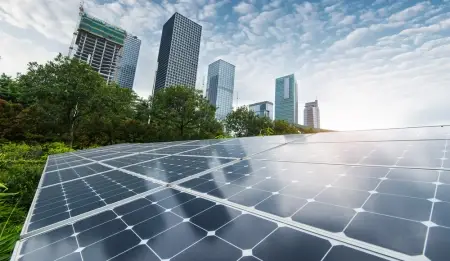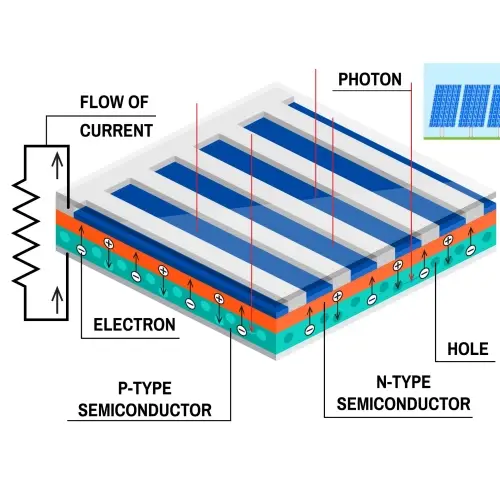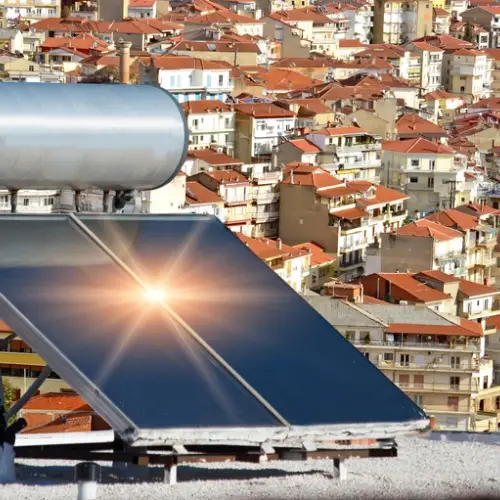
A solar panel (or solar panel) is a device that captures the sun's radiant energy and converts it into another form of usable energy. There are two main types of solar panels: photovoltaic and thermal.
A photovoltaic solar panel is made up of photovoltaic solar cells that contain semiconductor materials capable of converting sunlight into electricity. These cells absorb photons of sunlight and release electrons, thus generating a direct current (DC) electric current . Photovoltaic panels are used to produce electricity and can be found in residential, commercial, and industrial systems.
On the other hand, a solar thermal panel is designed to harness the sun 's thermal energy and heat water or other fluids. These thermal panels are composed of solar collectors that absorb solar energy and transfer the heat to the water or circulating fluid. Solar thermal panels are primarily used to heat water in residential, commercial and industrial applications, and can significantly contribute to reducing conventional energy consumption for water heating.
Photovoltaic panels: electricity generation
Photovoltaic panels are designed for the production of electricity. This type of panel is made up of small solar cells that convert the Sun 's radiation into electrical energy thanks to the photovoltaic effect.
This type of solar panel is made of semiconductor materials that are usually derived from silicon. The panels are built by interposing two layers of silicon, each of which is treated in a special way to generate an electric field.
When a photon of light hits these layers, it knocks an electron out of a silicon atom. The free electrons flow in the same direction, generating an electric current due to the electric field created.
Photovoltaic solar panels generate electricity in the form of direct current and are usually accompanied by current converters to obtain alternating current.
How does it work? The photovoltaic effect
 Photovoltaic panels work thanks to the photovoltaic effect, a physical phenomenon that allows sunlight to be converted into electricity. This effect occurs in certain semiconductor materials, such as silicon, which are capable of generating an electric current when exposed to light.
Photovoltaic panels work thanks to the photovoltaic effect, a physical phenomenon that allows sunlight to be converted into electricity. This effect occurs in certain semiconductor materials, such as silicon, which are capable of generating an electric current when exposed to light.
Each photovoltaic panel is made up of many solar cells, which are the basic units where the photovoltaic effect occurs. When sunlight hits a solar cell, photons (light particles) transfer their energy to electrons in the semiconductor material. This extra energy allows electrons to break free from their atoms, creating electron-hole pairs (a hole is the absence of an electron). Because of the structure of the cell, free electrons move to one side of the semiconductor, while holes move to the opposite side, creating an electrical potential difference, or voltage.
This movement of electrons generates a direct current that can be used directly to power electrical devices or, through an inverter, converted into alternating current for use in homes or industries. Thus, photovoltaic panels transform solar energy into electrical energy in a clean and sustainable way.
Materials used
Solar cells are generally made of crystalline silicon or gallium arsenide. Gallium arsenide crystals are created for these uses, while silicon crystals are also produced for consumption by the microelectronics industry.
Depending on the silicon configuration of the solar cells, photovoltaic panels are classified into polycrystalline, monocrystalline and thin-film solar panels. The main differences between them are cost and efficiency.
Construction technique
A 6 cm silicon cell exposed to 1 AU direct light can produce a current of 0.5 amps at 0.5 volts. Gallium arsenide is even more efficient than silicon.
The crystal is cut into small discs and polished to eliminate the danger of cutting. Dopants are then inserted into the discs and metal drivers are deposited on each surface: a small connector on the surface facing the sun and a connector on the other side.
Solar panels are constructed from these cells cut into appropriate shapes. They are also protected from radiation and other damage by applying a layer of glass and cementing them onto a substrate (either a rigid or flexible panel).
Electrical connections are made in series-parallel to determine the total output voltage and must have a protective layer that must be a thermal conductor.
Photovoltaic cells that make up a solar panel
Although each photovoltaic cell provides a small amount of energy, an array of solar cells can generate enough energy to be useful.
The most common solar cell configurations are the following:
-
36-cell solar panels: This type of panel is the most compact on the market and the most recommended option for small, isolated installations. The 36 solar cells generate an output voltage of 12 volts.
-
60-cell solar panels. Uses 60 solar cells to obtain an output voltage greater than 24V.
-
72-cell solar panels. This type of photovoltaic module connects 72 solar cells to obtain a voltage greater than 24V and is mainly used in grid-connected installations.
Solar collectors: heat generation
Solar collectors are part of solar thermal energy installations.
 Its function is to take advantage of the sun 's heat energy to heat a liquid.
Its function is to take advantage of the sun 's heat energy to heat a liquid.
This type of solar panel works by circulating a fluid inside it. The panel captures heat energy from the sun. This fluid is heated as it circulates inside the collector.
Types of solar collectors
There are several types of solar collectors, each designed for specific applications depending on the temperature that needs to be reached:
- Low temperature collectors :
Flat solar collectors : These are the most common and consist of a flat surface that absorbs solar radiation. They are ideal for applications such as heating water for domestic use or space heating.
Vacuum tube collectors : These collectors are more efficient than flat collectors, especially in cold climates. They are made up of tubes that contain a vacuum inside, which reduces heat loss. - High Temperature Collectors :
Parabolic Mirror Solar Concentrators : These use parabolic mirrors to concentrate solar radiation onto a small receiver, thereby increasing the temperature. They are used in industrial applications or in electricity generation.
Flat Mirrors or Linear Fresnel Lenses : These technologies also concentrate solar radiation, but with a different design than the parabolic one, and are used in applications where high temperatures are required. - Very high temperature collectors :
Solar thermal power plants : These facilities use fields of adjustable flat mirrors that reflect solar radiation towards a single focal point. This type of collector is capable of reaching extremely high temperatures and is mainly used in large-scale electricity generation.
Examples of uses and applications
Installing solar panels offers the ability to generate electricity or heat, which expands their potential for use in a variety of applications.
Below are examples of photovoltaic solar panel applications:
-
Portable electronics: Solar panels are used to supply electricity and recharge batteries in consumer electronic devices such as calculators and portable devices.
-
Charging electric vehicles: Electric cars can charge their batteries using solar energy. This can be achieved by solar panels built into the vehicle or at charging stations.
-
Energy for buildings: In tropical and subtropical regions with abundant sunlight, large solar panels, such as solar collectors, are used to power buildings and homes.
-
Space applications: Spacecraft use solar batteries as their primary source of electrical generation. These batteries are highly efficient and sustainable, in contrast to nuclear and radioisotope power sources.
The main applications of solar collectors are:
-
Domestic hot water: Solar collectors are used to heat water used in homes and buildings, thus reducing the need for conventional heating systems.
-
Heating systems: They provide heat for heating systems in homes and buildings, reducing dependence on traditional heat sources.
-
Large-scale electricity production: In steam power plants, solar collectors are used to generate electricity on a large scale, using solar radiation as a heat source.